#Avian Influenza
Text

111 notes
·
View notes
Text
Emmanuel the Emu: A Story of HPAI Mismanagement
Emmanuel, the TikTok-famous emu owned by Taylor Blake of Knuckle Bump Farms, made national news last month when Highly Pathogenic Avian Influenza (HPAI) hit the farm. According to Blake’s initial Twitter thread, Knuckle Bump Farms lost 99% of their avian flock- over 50 individuals- in only three days. These deaths were attributed both to the disease itself and to a cull carried out by the Florida Department of Agriculture and Consumer Services, who did so with Blake’s permission. Emmanuel and a black swan named Rico were the only two survivors, with Emmanuel left unable to stand, unwilling to eat or drink, and quickly fading. Hundreds of thousands rallied behind Emmanuel on social media as Blake documented Emmanuel’s progress, reaching out to public figures like Dr. Pol of The Incredible Dr. Pol and Bindi Erwin of Crikey! It’s the Irwins for help when she failed to find any other sources for emu rehabilitation. But soon, controversy emerged.
Early on, avian influenza experts expressed concern that Blake was not wearing any PPE when interacting with a presumably HPAI-positive bird. Avian influenza is transmissible from bird to human which, combined with the virus’ ability to mix genes and rapidly change, means that PPE is universally recommended when dealing with a suspected or confirmed HPAI outbreak.

In response to concerns, Blake explained that “Emmanuel freaks out whenever we approach him wearing a mask” and that the farm is on a state-mandated quarantine for 150 days, which is the amount of time HPAI is estimated to survive in the environment under ideal conditions. This quarantine reportedly only allowed Blake, Blake’s girlfriend Kristian Haggerty, Blake’s family, and veterinary professionals to enter the property. “I have taken every precaution recommended by the FDA” Blake stated, referencing the Florida Department of Agriculture and Consumer Services (FDACS) rather than the Food and Drug Administration (FDA).
Many people, including HPAI experts, found this explanation unsatisfactory and instead decided to contact the FDACS and USDA directly. Both the FDACS and USDA work collaboratively to manage avian influenza outbreaks in Florida. Dr. Danielle Stanek of the Florida Department of Health clarified that the DOH can recommend that private individuals comply with CDC guidelines, which includes wearing full PPE when interacting with HPAI-infected birds, but they cannot mandate that they do so. Therefore, Blake’s decision to forgo PPE was hers to make, even if it wasn’t in accordance with the recommendations of the FDACS, CDC, USDA, and Florida DOH.
Just as discourse between experts and Emmanuel fans reached its peak, Blake announced that Emmanuel tested negative for HPAI. Instead, Emmanuel’s sudden decline was attributed to stress. “Emus are incredibly susceptible to stress. He was incredibly overwhelmed by the state coming in and euthanizing our flock . . . He stopped eating the day they depopulated.” His lingering issues- the inability to stand or walk independently, twisted neck (torticollis), continued inappetence and dehydration, and lethargy- were caused by a nighttime collapse that left Emmanuel “thrashing on the ground for hours, trying to get himself up”. “He never once had a single symptom of AI, other than not eating”, Blake stated.
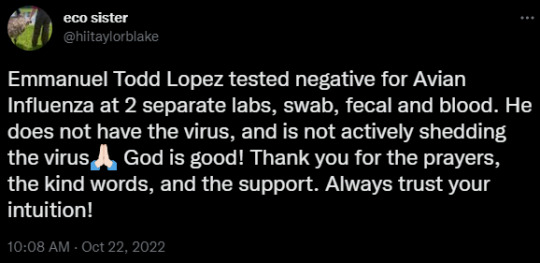
HPAI symptoms in birds varies depending on the species and the individual. In chickens, HPAI often presents as respiratory and digestive distress, followed quickly by death. In other poultry species, symptoms may also include the nervous system, causing “tremors, twisted necks, paralyzed wings, laying down and pedaling”. Ratites- referring to the diverse group of keel-less birds that include emus, ostriches, rheas, kiwis, and cassowaries- also tend to develop neurological symptoms. Notably, emus can present with twisted necks (torticollis), ataxia (discoordination), leg and wing paralysis, inability to stand, decreased food and water consumption, purple discoloration or swelling of the legs and head, and lethargy. This corresponds with many of the symptoms Blake has documented in Emmanuel. And it should, considering that Emmanuel did test positive for HPAI.
Test results completed on October 27th, 2022 at the USDA’s National Veterinary Services Laboratories showed that Emmanuel’s serum sample, collected six days after the start of the outbreak, contained antibody levels that were consistent with recent infection.
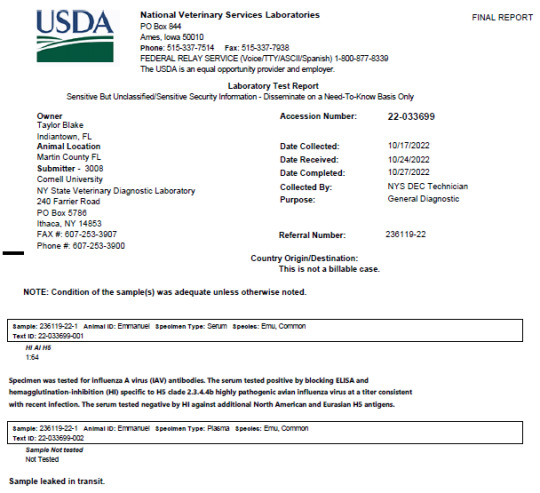
When Blake announced Emmanuel’s stress diagnosis, she was likely relying on information provided by a rapid test, which can provide results within 48 hours. These tests detect viral proteins that indicate active infection and virus shedding. Serology tests, on the other hand, look for the presence of antibodies produced in response to infection, not necessarily active infection. For an indeterminate number of days prior to the sample collection (October 17, 2022) Emmanuel had an active HPAI infection that, rather than stress, likely led to his rapid decline.
Why, then, was Emmanuel not included in the state’s cull on Knuckle Bump Farms? An email between Dr. Michael Short, the FDACS’ Animal Industry Director, and Kassandra Curiel of the FDACS’ Office of the Commissioner, answers this question. Dr. Short states that “USDA guidance is that ratites (emus and ostriches), black swans and exotic pet birds do not have to be euthanized due to lower risk”. Blake echoes this on her Twitter, when she says that “the state only focused on the “super spreaders” which are poultry species and ducks. Ratites aren’t included because they typically aren’t as susceptible.”.
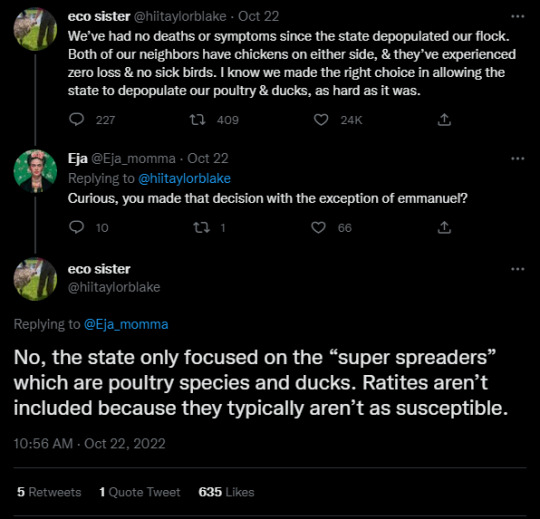
This allowed Knuckle Bump Farms’ four emus (Emily, Eliza, Elliot, and Emmanuel) and three black swans (two unnamed females and Rico), to be exempted from the cull. I cannot find any reference, either in USDA literature or anywhere else, that supports Dr. Short’s statement. In fact, all the literature that I reviewed and all the experts I talked to during my research only confirmed the devastating effects that HPAI can have on both ratites and black swans. This, coupled with the fact that three of Knuckle Bump Farms’ four emus and two of their three black swans died when “the virus hit them extremely hard and very quickly”, calls Dr. Short’s statement into question.
The USDA was also unable to substantiate Dr. Short’s statement. When asked how exemptions to culls were determined they explained that, rather than look at individual species, the USDA classifies HPAI-infected domestic birds as either commercial, backyard poultry, or backyard non-poultry. These definitions ascribe risk of potential HPAI spread by determining the level of contact a poultry premise has with other poultry premises. If a private farm or private household, where the poultry does not have any contact with poultry beyond the property, has an outbreak then they are classified as a non-poultry premises, even if they have chickens, turkeys, or other poultry birds. These non-poultry premises can thus be exempted from culling all their birds by being placed on quarantines by state officials, provided that they adhere to the quarantine and continue to not have contact with any poultry facilities. Knuckle Bump Farms does not sell poultry products; therefore, they were classified as backyard non-poultry and eligible for quarantine. The FDACS seems to have added their own interpretation onto this guidance when they specify ratites, black swans, and exotic pet birds as “lower risk”. I reached out to Dr. Short for comment but received no response.
This isn’t the only time Dr. Short and, by extension, the FDACS demonstrated faulty logic. In that same email between him and Curiel, Dr. Short used this comparison to explain why a citizen’s concern about Emmanuel’s exemption from the cull was unfounded.
“I have heard of only one report of a clinically ill human, over the past 1.5 years of a national response to the current avian flu outbreak. The risk of HPAI to the owner is much less than occurred with household pets that tested positive for SARS-CoV-2 (Covid). I am assuming no one would advocate to euthanize all pets testing positive for Covid (At least I have not heard of anyone asking us to euthanize pets).
The risk of avian influenza is constantly occurring with all the wild birds in South Florida. My understanding (not being a human health expert) is the risk to people, especially children and those immuno-compromised at public or private lakes, ponds and waterways from the AI being shed by water fowl is much greater than the sick emu at knuckle bump farm.”
Dr. Ben Golas, a VMD and postdoc with the USGS who is currently working on avian influenza research, weighed in. “It’s a bit like comparing apples and oranges to talk about risk of transmission of COVID vs. HPAI. With COVID, our primary concern is human-to-human contact. [. . .] With HPAI, farm animals are euthanized not only because the disease spreads within the farm flock like wildfire, but also to prevent spreading infection locally to other farms, because HPAI virus can be stable in the environment.”
The CDC agrees. “There is no evidence that animals play a significant role in spreading SARS-CoV-2, the virus that causes COVID-19, to people. […] It’s important to remember that people are much more likely to get COVID-19 from other people than from animals. There is no need to euthanize or otherwise harm animals infected with SARS-CoV-2.” When it comes to HPAI, however, they emphasize that human-to-human spread is rare and often limited to only a few individuals. Bird-to-human transmission is the primary method of human infection, with each new infection increasing the risk that a new, more virulent strain will emerge. This, along with the potential for massive bird-to-bird outbreaks that could devastate both wildlife and industry, is why complete depopulation (euthanasia) is standard for HPAI and not COVID-19.
The FDACS seems to be operating on contradicting and unsubstantiated information when it comes to managing HPAI outbreaks. Unsurprisingly, the employees seem equally conflicted in their internal emails regarding Knuckle Bump Farms. One Florida USDA representative noted, while forwarding a citizen concern about Blake’s lack of PPE, that “her face is real close to a bird that has HPAI”. Another USDA employee responded “actually, in one of the pictures she appears to be kissing it on the head.”. Dr. Kendra Stauffer of the USDA wrote, “. . . part of the allowing the pet bird to live was that there were rules the owner was to follow from DOH, which clearly she is not”.
Other employees, however, were eager to show their support. Commissioner Nikki Fried of the FDACS posted a photo of her, Blake, and Haggerty, and later posted a photo of herself drinking Knuckle Bump Farms’ branded beer while wearing an Emmanuel t-shirt.
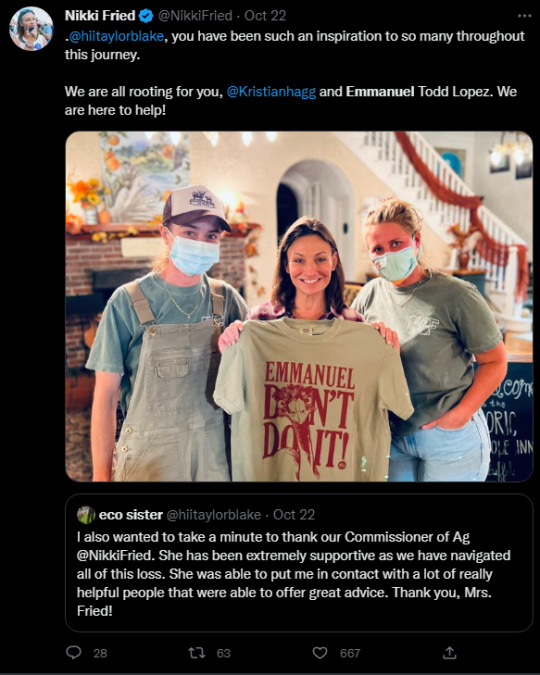
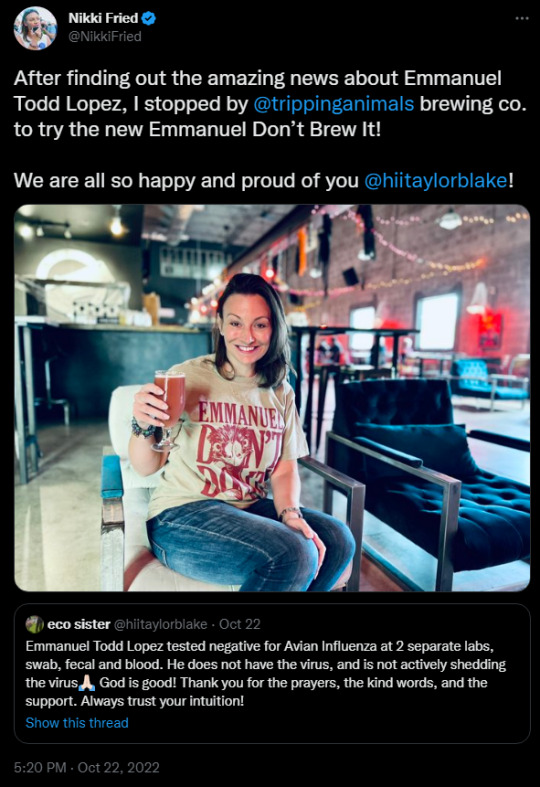
Fried’s support generated a lot of concern, particularly amongst local farmers. One Florida emu farmer stated, “my disappointment and concern is 100% with the actions of Nikki Fried as Agricultural Commissioner to allow some birds to be exempt from depopulation, including emus, for no quantifiable reason. Emus are susceptible to HPAI. Emus in other states have contracted HPAI in this current outbreak and they either died on their own or were put down. Research shows they are susceptible to HPAI, and can spread it to other birds and humans. The decision by Fried and FDACS makes no sense and it sets a dangerous precedent.”
Considering that Blake has over 847.4K followers on Twitter, 938K on Instagram, and 2.4 million on TikTok, the precedent the FDACS and USDA have set here is, indeed, dangerous. Many of Blake’s followers learned about avian influenza for the first time through her documentation of Emmanuel’s illness and the state’s response to the outbreak. “I watch for Emmanuel updates every day! This has also been a great lesson for many people in farming education.”, one follower said. Another echoed this sentiment, saying “Thank you for taking the time to let us know what’s going on, and answering questions. You truly are an educator”.
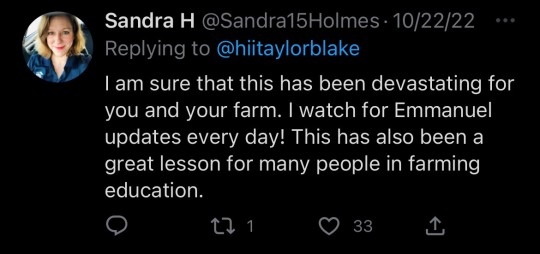

Herein lies the problem. Knuckle Bump Farms is a small, backyard operation. Through social media, however, they reach millions. This specific outbreak of HPAI and its subsequent (mis-)management by the FDACS and USDA has now set the standard for many, rather than the exception. Blake’s public failure to comply with PPE recommendations, the lack of transparency regarding Emmanuel’s true diagnosis, a similar lack of transparency within the FDACS and USDA regarding this outbreak, exemptions to cull protocols made with seemingly no supporting data, and a publicly-elected official openly (and financially) supporting Blake through this process, all pose a serious threat to public confidence in HPAI management and future public health. The concerns of farmers, virologists, public health workers and organizations, wildlife rehabilitators, and animal sanctuaries have been ignored, particularly when they asked whether Emmanuel’s fame and the risk of public backlash led to the FDACS’ decision to leave him and several other symptomatic birds alive. It seems, through this research, that there is more support for this theory than the narrative we’ve been provided until now. It is my hope that, with the publishing of this information, the very real concerns raised by people directly effected by HPAI will be given the weight they deserve.
Please take this opportunity to learn about avian influenza from reputable sources:
Protecting Birds from Avian Influenza
Avian influenza and PPE
CDC Avian Influenza
USDA HPAI Response Plan
Florida Avian Influenza Update (Oct 2022)
A huge thank you to the following experts who generously answered my questions: Dr. Ben Golas, Dr. Jim Wellehan, and Dr. Jennifer Riley.
2K notes
·
View notes
Link
The threat is thought to be so severe that it could wipe out the species entirely.
The discovery comes after the distinctive bird's genome was sequenced for the first time in 2021.
Ordinarily, this achievement would be something to celebrate from a scientific perspective – but a comparison with closely-related northern hemisphere white swans has revealed that certain key immune genes are missing from its DNA.
That's likely to be, at least partly, down to the way that the black swan is isolated geographically. These animals haven't had the same exposure to pathogens that are found outside of southeast and southwest Australia, the areas where it primarily lives and breeds.
"[B]lack swans are extremely sensitive to highly pathogenic avian influenza – HPAI which is often referred to as bird flu - and can die from it within three days," says microbiologist Kirsty Short from the University of Queensland in Australia.
Continue Reading
94 notes
·
View notes
Text
Video captioned by PandemicHub!

#public health#pandemic#Pandemic info#H5N1#Avian influenza#Avian Flu#Laughter in light#Immunology#Immunologist
38 notes
·
View notes
Text
DAILY DOSE: Texas Bird Flu Found in Humans, Cattle Alert; Germany Partially Decriminalizes Cannabis Amid Controversy.
TEXAS BIRD FLU ALERT AFTER HUMAN INFECTS FROM COW.
Texas health officials have issued an alert about the first confirmed human infection with a bird flu virus in a person exposed to infected dairy cows, presenting with conjunctivitis. This incident underlines the global concern regarding the H5N1 clade 2.3.4.4b flu strain, which has previously devastated bird populations and is now found in…

View On WordPress
#Africa#Asia#Australia#avian influenza#Bacteria#cannabis#diet#Europe#Featured#food#influenza#nicotine#North America#society#South America#space travel
3 notes
·
View notes
Text
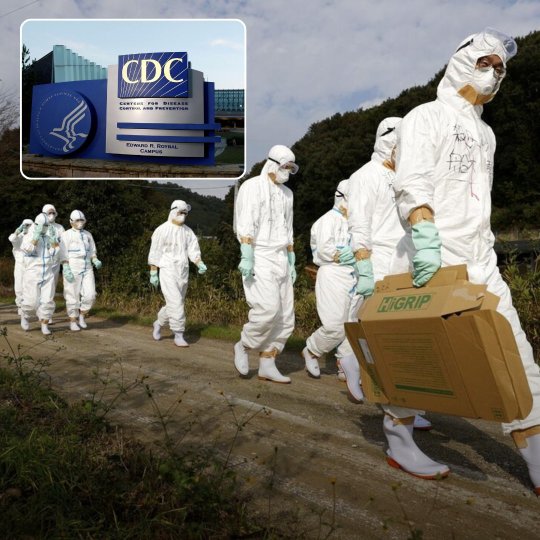

Although the risk to the public remains low, CDC wants state public health officials to be prepared to respond to ensure that they have up-to-date operational plans to respond to avian influenza at the state level.
The human mortality rate for H5N1 is 60%, says #WHO.
#H5N1 #WearN95 #CDC #BirdFlu #AvianInfluenza
1 note
·
View note
Text
Oh fuck this is bad this is very bad.
It doesn't sound like we have easy mammal-to-mammal transmission yet; the mammals are supposed to have got it from eating dead birds.
But influenzas are mercurial and slutty viruses. They adapt like the Borg. They adapt like my cat figuring out which treats hide pills.
The more mammals highly pathogenic H5N1 finds itself in, the greater the chance that one of those mammals is carrying its own influenza virus, a virus that does transmit between mammals easily. And then the bird virus and the mammal virus love each other very much and make a virus baby. And if we're unlucky, that virus baby has the contagiousness of mammal flu (very, airborne) and the fatality rate of bird flu (over 90% in birds, over 50% in humans).
9 notes
·
View notes
Text
Brazilian minister calls for debate on animal health crises
The minister of Agriculture and Livestock of Brazil advogaces a worldwide rethink within the WOAH on animal products and the adjustment of avian flu protocol.

The minister of Agriculture and Livestock of Brazil, Carlos Fávaro (pictured), advocates a worldwide discussion on health crises involving animal products, the Ministry reported on Friday (14). The minister believes that the debate should take place within the World Organization for Animal Health (WHOA) as a way to prevent a supply collapse.
“The current protocol is very strict and even dangerous for the world’s poultry supply. Here in Brazil, for example, if an avian flu case occurs at a commercial farm in Amazonas, the entire system shuts off,” he explained.
Continue reading.
#brazil#politics#brazilian politics#economy#farming#avian influenza#mod nise da silveira#image description in alt
3 notes
·
View notes
Link
You would think more wild birds versus poultry were getting this, not so.
1 note
·
View note
Text
My latest Rainy Rambles column discusses the details on avian flu, particularly H5N1. While its effects may soon be waning as spring migration winds down and the temperatures rise, it's not gone entirely. And there's a very good chance it'll be back as the birds move around again. Find out why it's such a threat and what to do at the link below.
Also, if you've enjoyed this article, feel free to drop the Coast Weekend a line saying so at editor(at)discoverourcoast(dot)com :)
#avian flu#avian influenza#H5N1#flu#influenza#birds#health#wildlife#poultry#chickens#bird feeders#migration#bird migration#nature#animals
3 notes
·
View notes
Text
"As the possibility of a new pandemic looms, influential figures are telling us we shouldn’t have been so worried about the last one. This spells trouble."
#mask up#covid#covid 19#h5n1#bird flu#avian influenza#covid isn't over#pandemic#covid conscious#long covid#covid is airborne#wear a mask#coronavirus
120 notes
·
View notes
Text
Food Week April 26, 2024
Welcome to Food Week April 26. You don’t want to pass over all the cool stuff this week, what with cookie wars, new look Matzo, secret McDonald’s menu items, AI in milk, meats in sweets and a whole lot more. So have a Nuka Cola and Enjoy.
MACRO
Biden Administration raises the minimum salary at which workers can be considered salaried management and therefore not eligible for overtime. to FTC…

View On WordPress
#avian influenza#hydroponics#koch#kroger albertson&039;s#microplastics#popeyes#regenerative agriculture#Sam Adams#water issues
0 notes
Text
Understanding Avian Influenza: Navigating H5N1 Bird Flu with CDC Guidance
The H5N1 avian influenza, commonly known as bird flu, continues to capture global attention as it persists in wild bird populations around the world. Recently, it has also been affecting poultry and, surprisingly, U.S. dairy cows. With a recent human case reported in a U.S. dairy worker, the Centers for Disease Control and Prevention (CDC) is vigilantly monitoring the situation to ensure public…

View On WordPress
#avian influenza#avian influenza summary#bird flu updates#CDC guidance#CDC recommendations#H5N1 bird flu#human cases#poultry outbreaks#public health#safety precautions
0 notes
Text
wow, so the "Parrot Fever🦜" (Chlamydia psittaci) that's killed 5 people so far in europe increases avian influenza virus🦠 H9N2 mortality by suppressing the immune system. does it make H5N1 more lethal too?🐓 🛟 🔬
0 notes
Text
DAILY DOSE: England's Women's Health Waitlists, Screening Lags Surge; Bird Flu Ravages Elephant Seals in Argentina.
ENGLAND’S WOMEN FACE CRITICAL DELAYS IN HEALTHCARE.
In England, nearly 600,000 women are on a waiting list for gynecological treatment, marking a 33% increase over two years. This surge includes a 43% rise in women waiting over a year for treatment. Additionally, cervical cancer screening rates fall below the government’s 80% target, with only 68.7% coverage. For breast cancer, 26% of women with…

View On WordPress
#Africa#Asia#Australia#avian influenza#brain#cognition#Europe#Featured#Genetics#healthcare#influenza#memory#North America#South America#space exploration#zoology
0 notes
Text

We've seen exponential growth in #AvianInfluenza A (#H5N1)
outbreaks in birds and mammals since 2020.
US cows have been infected and the virus detected in cow's milk.
Transmission is being investigated, as is the role of #pasteurization in the inactivation of the virus.
#BirdFlu
https://www.who.int/publications/m/item/joint-fao-who-woah-preliminary-assessment-of-recent-influenza-a(h5n1)-viruses
0 notes